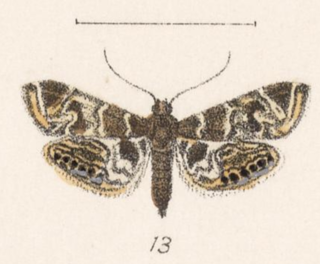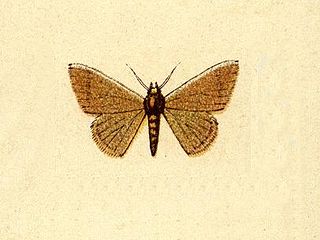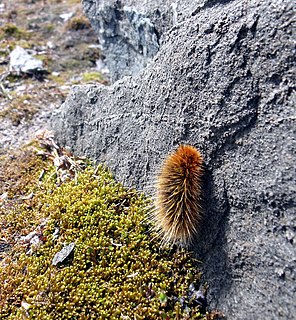Related Research Articles
Psammathodoxa is a genus of moths of the family Erebidae. The genus was erected by Harrison Gray Dyar Jr. in 1921.

Cordyligaster is a genus of bristle flies in the family Tachinidae.
Hyposmocoma swezeyi is a species of moth of the family Cosmopterigidae. It was first described by August Busck in 1914. It is endemic to the Hawaiian island of Oahu. The type locality is Kaimuki, Honolulu.

Usingeriessa onyxalis is a moth of the family Crambidae. It is native to southern Texas, Mexico and Central America. It is an introduced species in Hawaii.

Harrison Gray Dyar Jr. was an American entomologist. Dyar's Law, a pattern of geometric progression in the growth of insect parts, is named after him. He was also noted for eccentric pursuits which included digging tunnels under his home. He had a complicated personal life and along with his second wife he adopted the Baháʼí Faith.

Copaxa is a genus of moths in the family Saturniidae first described by Francis Walker in 1855.

Leptostales kinstonensis is a moth of the family Geometridae. It is found on the Antilles and St. Vincent.

Arctia opulenta is a moth of the family Erebidae. It was described by Henry Edwards in 1881. It is found from Alaska through northern British Columbia to Labrador. The habitat consists of arctic tundra and alpine and subalpine tundra.
Donacaula uxorialis is a moth in the family Crambidae. It was described by Harrison Gray Dyar Jr. in 1921. It is found in North America, where it has been recorded from Florida and Texas.
Scoparia jonesalis is a moth in the family Crambidae. It was described by Harrison Gray Dyar Jr. in 1915. It is found on the Bermuda Islands.
Bocchoropsis plenilinealis is a moth in the family Crambidae. It was described by Harrison Gray Dyar Jr. in 1917. It is found in Guyana, French Guiana, Suriname and Cuba.
Diathrausta angustella is a moth in the family Crambidae. It was described by Harrison Gray Dyar Jr. in 1913. It is found in Panama.
Udea absolutalis is a moth in the family Crambidae. It was described by Harrison Gray Dyar Jr. in 1913. It is found in Guyana.
Eudeilinia luteifera, the southern eudeilinea moth, is a moth in the family Drepanidae. It was described by Harrison Gray Dyar Jr. in 1917. It is found in the United States, where it has been recorded from Texas to Florida.
Dichomeris varronia is a moth in the family Gelechiidae. It was described by August Busck in 1913. It is found in Panama and Guyana.
Chlamydastis tryphon is a moth in the family Depressariidae. It was described by August Busck in 1920. It is found in Guatemala.
Moca rugosella is a moth in the family Immidae. It was described by August Busck in 1914. It is found in Guyana.
Parachalcerinys is a genus of wasp. As of 2018, three species are recognized, which are all found in Australia.
Scoliocentra tincta is a species of fly in the family Heleomyzidae.
Phobetron dyari is a species of slug caterpillar moths in the genus Phobetron and the family Limacodidae.
References
- ↑ Dyar, Harrison (1920). Insecutor Inscitiae Menstruus: A Monthly Journal of Entomology. Vol. 8–9. Harrison G. Dyar.
- ↑ Heiman, Maury J. (October 20, 2015). "Species Psammathodoxa cochlidioides - Hodges#8529". BugGuide. Retrieved November 23, 2019.
- ↑ Dyar, Harrison G. (1921). "New American Noctuidae and Notes". Insecutor Inscitiae Menstruus. 9: 43.
 This article incorporates text from this source, which is in the public domain .
This article incorporates text from this source, which is in the public domain .